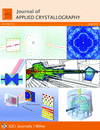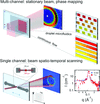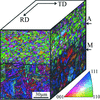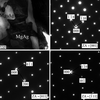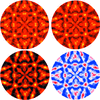issue contents
June 2018 issue

Cover illustration: QUOKKA, the pinhole small-angle neutron scattering instrument at the OPAL Research Reactor, Australia [Wood et al. (2018). J. Appl. Cryst. 51, 294-314]. Graphic design: Karl Mutimer; data courtesy of Kathleen Wood, Lillian Caruana, Norman Booth and Elliot Gilbert.
editorial
Free 

A virtual special issue of Journal of Applied Crystallography on advanced neutron scattering instrumentation looks at some of the latest developments in source and instrument suite design, high-performance instrumentation, and software. These developments are enabling new opportunities for science discovery through technologies such as detectors, sample environments and data acquisition advances.
feature articles
Open  access
access
 access
accessA review of materials and fabrication methods provides recommendations for microdevices for small-angle neutron scattering.
research papers
Described here is the implementation of the high-resolution neutron Larmor diffraction technique using superconducting magnetic Wollaston prisms at the High-Flux Isotope Reactor of Oak Ridge National Laboratory (ORNL), Tennesse, USA. Recent results are discussed.
Open  access
access
 access
accessA fast and medium-resolution neutron powder diffraction option for `energy research with neutrons' (ErwiN) at the high-flux FRM II neutron source at the Heinz Maier-Leibnitz Zentrum (MLZ) is described.
A new diffractometer that can measure membrane proteins and protein complex crystals with large lattice constants has been designed. Simulation studies confirmed the capability of peak separation for a lattice length of 250 Å along each axis at dmin = 2.0 Å and a satisfactory radiation safety level.
The mathematical body of the time-of-flight reflectometry data-reduction software COSMOS is described. COSMOS is used on the reflectometers D17 and FIGARO at the Institut Laue–Langevin in Grenoble, France.
This article describes event-based acquisition at the Spallation Neutron Source; including both a description of methodology and a wide variety of examples.
An experimental technique has been developed for in situ neutron diffraction measurement during cyclic tests at J-PARC. In an applied cyclic electric field, the responses of lattice strain and domain switching of the piezoelectric material in a piezoelectric actuator were successfully observed using the developed technique.
An algorithm is presented for the correction and merging of intensities from neutron Laue diffraction instruments. Examples are included using experimental data for comparison with earlier Laue data-processing algorithms.
Open  access
access
 access
accessMARIA is a world class vertical sample reflectometer dedicated to the investigation of thin films in the fields of magnetism, soft matter and biology. With the elliptical vertically focusing guide and a wavelength resolution of Δλ/λ = 10%, the non-polarized flux at the sample position amounts to 1.2 × 108 n (s cm2)−1. Besides the polarized and non-polarized reflectivity mode for specular and off-specular reflectivity measurements, MARIA can also be used to carry out grazing-incidence small-angle neutron scattering investigations.
This article provides a detailed comparison of various cross-correlation methodologies for resolving pseudosymmetry in γ-TiAl using cross-correlation electron backscatter with high-fidelity dynamically simulated EBSD patterns. Sensitivities to pattern center error, pattern resolution and pattern quality are established for both simulated and experimental samples of γ-TiAl.
Download citation


Download citation


This study shows that with temperature-dependent high-resolution X-ray and neutron diffraction the physical origin of observations cannot be revealed on the basis of agreement factors alone. However, when the diffraction results were combined with additional electron microscopy and electron probe microanalysis, it was possible to confirm that a segregation of substituents results in a complex reflection splitting and phase coexistence that can be misinterpreted as monoclinic symmetry.
Direct inversion of normalized crystal truncation rods to reconstruct real-space interface structures was performed by retrieving the phase information using Hilbert transformation (Kramers–Kronig relation).
Open  access
access
 access
accessA low-temperature stage for X-ray powder diffraction in the range 40–315 K is described. A unique feature of the apparatus is that samples may be introduced into the stage (and removed from it) at any temperature above 80 K.
Download citation


Download citation


Open  access
access
 access
accessAn apparatus for the compression of materials to ∼2 GPa and subsequent rapid chilling to 80 K with extraction to ambient pressure is described. The partial resolution of a long-standing problem concerning the high-pressure phase behaviour of a water-rich salt hydrate is demonstrated using the equipment.
An analysis of multiple scattering in ultra-small-angle X-ray scattering (USAXS) and X-ray photon correlation spectroscopy (XPCS) from a colloidal sample is presented. The high resolution of a pinhole USAXS instrument enabled subtle features of multiple scattering to be resolved.
A composite epitaxial microstructure of a c-axis-oriented YBa2Cu3O7−δ film with embedded a-axis grains on a (110) NdGaO3 substrate was successfully grown by liquid phase epitaxy.
A series of numerical experiments demonstrate that texture, the number of peak pairs and the sampling method drastically affect diffraction-based phase fraction measurements. Hexagonal grids produce minimal bias errors and provide a robust way to measure phase fractions in textured materials.
Open  access
access
 access
accessMultireflection grazing-incidence X-ray diffraction was used to investigate the structure and residual stress gradients in the near-surface region of mechanically treated titanium samples. The development of this method by using a white synchrotron beam during an energy dispersive diffraction experiment is proposed.
Open  access
access
 access
accessThe division of neutron detector panel regions has improved the precision of complex texture evaluation and appropriate sample rotation enhances the texture reliability in a limited neutron beam time. The TAKUMI instrument has achieved satisfactory texture precision for a limestone standard sample. The compressive rolling direction–transverse direction in-plane stress field was quantitatively measured in martensite layers of a martensite–austenite multilayered steel, and this stress field was found to originate from the martensite transformation strain and the linear contraction misfit between austenite layers and newly transformed martensite layers.
A laboratory-based X-ray powder diffractometer equipped with a magnet for the investigation of temperature- and magnetic field-dependent phase transitions is presented.
Small-angle neutron scattering has been used to characterize deuteride particles in Zircaloy 4 as a function of deuterium concentration. Anisotropic scattering is observed at high deuterium concentration. Azimuthal and elliptical analyses are performed. Ex situ applied tensile loading leads to inconclusive effects on the deuteride phase.
This article reports the first realization of an in situ tensile test combined with Bragg coherent diffraction of a nanowire.
Quantitative X-ray diffraction and X-ray fluorescence analyses of mixtures – unified and simplified
A unified theory and practice for both X-ray diffraction and X-ray fluorescence is presented. It eliminates some 80% of the laboratory work associated with current practice with a precision of ±5% or better.
An in situ synchrotron X-ray total scattering setup has been developed that allows observation of the phase transformation in hydrogen storage materials upon hydrogenation. This setup can be used to study the change in average and local structures during hydrogen absorption–desorption reactions.
MgAlxOy nanocrystals with unreported monoclinic structures have been successfully synthesized under high temperature. The introduction of domain boundaries may greatly increase the strength of low-dimensional MgAlxOy.
Two new twinning modes found in a pure single crystal are experimentally studied, and their crystallographic characteristics are determined. One has a habit plane that is not invariant, and the other has the lowest shear value ever reported in metals.
This article describes a resolution matrix for spin-echo three-axis spectrometers which includes instrument detuning effects.
Open  access
access
 access
accessSeparation of size and strain effects on diffraction line profiles has been studied in a round robin involving laboratory instruments and synchrotron radiation beamlines operating with different radiation, optics, detectors and experimental configurations. The studied sample, an extensively ball milled iron alloy powder, provides an ideal test case, as domain size broadening and strain broadening are of comparable size.
Download citation


Download citation


Electron backscatter diffraction and transmission electron microscopy have been used with X-ray diffraction to confirm the existence and crystallographic information of the Mg7Ag3 phase in the Mg–Ag binary alloy system.
CCDC reference: 1845414
A line broadening effect due to modulated electron density in a liquid layer surrounding a nanocrystal is theoretically predicted. The results of simulations, based on an analytical expression for the diffraction profile, are compared with existing experimental data
A report is given of a new method of measuring a neutron scattering length by fitting a correlation function measured by total neutron scattering. The method is used to determine values of 9.71 (18) and 12.1 (9) fm for the scattering lengths of the isotopes 193Ir and 191Ir, respectively.
The ultra-small-angle X-ray scattering (USAXS) facility at the Advanced Photon Source has been significantly upgraded to provide rapid USAXS scanning at high X-ray energies together with associated pinhole small-angle X-ray scattering (SAXS) and wide-angle X-ray scattering (WAXS) measurements. Complete USAXS/SAXS/WAXS data can be obtained within 5 min, allowing flexible in situ and operando measurement capabilities under a wide range of conditions.
A combined method for quantitative texture determination and line profile analysis using synchrotron high-energy X-rays is presented. It is applied for characterizing the recovery and continuous recrystallization of a cold-rolled aluminium nanocomposite.
A method to determine the coverage of a given diffraction instrument as a percentage of 2π pole figure hemisphere using the Generic Mapping Tools (GMT) and ImageJ is presented.
teaching and education
Free 

Three-dimensional-printed models of optical indicatrices are presented as learning and teaching support materials. The models were designed as dissection puzzles that can be disassembled to analyze relevant sections and a number of crystal optics concepts such as optical axes, vibration directions, wave normals, ray paths and their geometrical relationships. The STL files of the presented models are made available with this paper.
Free 

Student-centred guest lecturing that combines themed presentations, hands-on workshops (whenever possible) and small group conversations was introduced into a chemical crystallography class.
Free 

The various settings used to describe the crystal structure of quartz are described. As an example, a correction is made to the description of the structure of quartz in a recent paper [Huang, Gog, Kim, Kasman, Said, Casa, Wieczorek, Hönnicke & Assoufid (2018). J. Appl. Cryst. 51, 140–147].
short communications
The paper presents the derivation of the commonly used formulations of pair distribution functions for multiple phase systems.
Download citation


Download citation


Thermoelectric materials of Ga-doped ZnO containing the secondary phase Ga2O3(ZnO)m of long-period structure were analysed by a (3 + 1)-dimensional superspace approach.
computer programs
Download citation


Download citation


This article describes recent developments in the computer program DSR. In particular, improvements have been made to the graphical user interface, and to the avoidance of operating errors by recognizing them.
CCDC reference: 1822173
A software package is presented for nearly real-time display of diffractograms during X-ray photoelectron diffraction data acquisition and for processing and analysis after an experiment.
Open  access
access
 access
accessA tool to visualize the results of a series of Rietveld analyses is presented, allowing identification of analysis problems, prediction of suitable starting values and acceleration of scientific insight from the experimental data.
A tool is presented that provides automatic and user-independent quantification of specific radiation damage events in structures derived by X-ray macromolecular crystallographic techniques.
Graphical-user-interface-based software is described for the imaging and processing of Laue data from continuous neutron sources.
addenda and errata
Free 

Errors about left-handed (laevorotatory) quartz and right-handed (dextrorotatory) quartz in the paper by Huang, Gog, Kim, Kasman, Said, Casa, Wieczorek, Hönnicke & Assoufid [J. Appl. Cryst. (2016), 51, 140–147] are corrected.
Open  access
access
 access
accessA typographical error in the article by Niebling, Björling & Westenhoff [J. Appl. Cryst. (2014), 47, 1190–1198] is corrected.


 journal menu
journal menu








